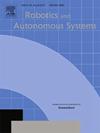Energy-efficient motion planning for robotic systems using polynomials in the Chebyshev basis
IF 4.3
2区 计算机科学
Q1 AUTOMATION & CONTROL SYSTEMS
引用次数: 0
Abstract
Motion profile optimization is a powerful technique for enhancing the efficiency of robotic systems without necessitating hardware modifications. Nonetheless, the prevailing usage of piecewise or polynomial position functions can often require a high number of design parameters or result in unbounded optimization problems. This paper presents a novel approach employing polynomials expressed in the Chebyshev basis for the position function of multi-degree-of-freedom (DOF) systems, enabling substantial performance improvements with a minimal number of design parameters while enabling the use of a bounded design space. More specifically, this work focuses on reducing energy consumption while maintaining a fixed motion time. Moreover, by symbolically formulating the motion profile, it is demonstrated that kinematic constraints can be linearized, leading to accelerated convergence in the optimization process. To illustrate the robustness of the proposed method under different operational conditions, optimizations were executed on three distinct motion tasks and a range of payload values, and compared to a state-of-the-art method. Experimental results strongly validate the effectiveness of the proposed approach, demonstrating a reduction in root mean square (rms) torque by up to −47.6% with a limited number of design parameters for each joint.
基于切比雪夫基多项式的机器人系统节能运动规划
运动轮廓优化是一种无需修改硬件即可提高机器人系统效率的强大技术。尽管如此,普遍使用的分段或多项式位置函数通常需要大量的设计参数或导致无界优化问题。本文提出了一种利用切比雪夫基表示的多项式求解多自由度(DOF)系统位置函数的新方法,在允许使用有界设计空间的同时,以最少的设计参数实现了性能的实质性改进。更具体地说,这项工作的重点是在保持固定运动时间的同时减少能量消耗。此外,通过对运动轮廓的符号化表述,证明了运动约束可以线性化,从而加快了优化过程的收敛速度。为了说明该方法在不同操作条件下的鲁棒性,对三种不同的运动任务和一系列有效载荷值进行了优化,并与最先进的方法进行了比较。实验结果有力地验证了所提出方法的有效性,表明在每个关节的设计参数数量有限的情况下,均方根(rms)扭矩减少高达- 47.6%。
本文章由计算机程序翻译,如有差异,请以英文原文为准。
求助全文
约1分钟内获得全文
求助全文
来源期刊

Robotics and Autonomous Systems
工程技术-机器人学
CiteScore
9.00
自引率
7.00%
发文量
164
审稿时长
4.5 months
期刊介绍:
Robotics and Autonomous Systems will carry articles describing fundamental developments in the field of robotics, with special emphasis on autonomous systems. An important goal of this journal is to extend the state of the art in both symbolic and sensory based robot control and learning in the context of autonomous systems.
Robotics and Autonomous Systems will carry articles on the theoretical, computational and experimental aspects of autonomous systems, or modules of such systems.
 求助内容:
求助内容: 应助结果提醒方式:
应助结果提醒方式:


